The modern workplace likes to “move fast and break things.” It places a premium on speed, efficiency, and instant solutions. It lives by the mantra of building without inhibition (or fear of consequence). It reflects in the form of 5-minute pow-wows and “post-mortems.” It lives in the now, where the “future” is tomorrow.

But some problems simply can’t be solved by 10x-ing, or optimizing, or “growth hacking.” Some problems, it turns out, require time — lots of it.
In the quest for disruption, long-term thinking is often forgotten. The Long Now Foundation, a non-profit based in the epicenter of the tech world, wants to change that.
You may know Long Now best as the org working with Jeff Bezos to build a very expensive clock inside a remote Texas mountain — a 500-foot orb of insanity that will bong once per century and keep time for 10k years. But the clock is more than a mess of gears, bearings, and chimes: It is a colossal monument to doing things “slower and better.”
I recently chatted with Long Now executive director (and clock project lead), Alexander Rose, on the importance of long-term thinking, Silicon Valley’s myopia, and — of course — this mysterious clock everyone’s talking about.
The transcript below has been lightly edited for clarity and length.
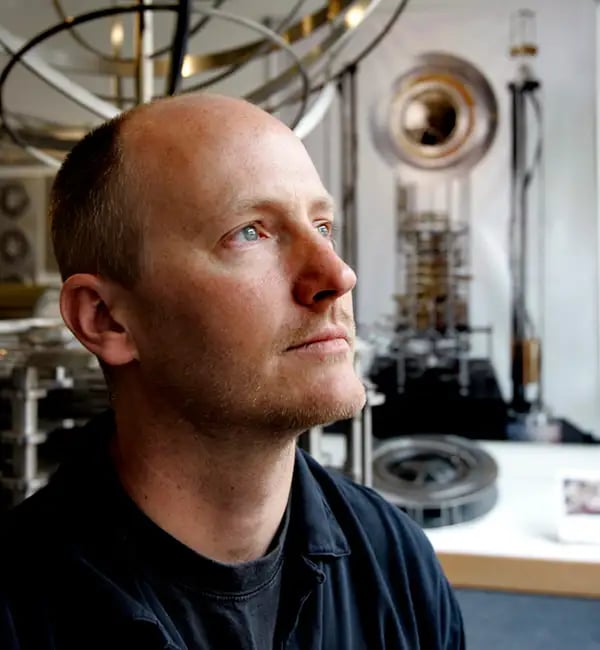
ZC: First off, what is the Long Now Foundation?
AR: Long Now was founded as a non-profit in 1996 by [legendary composer] Brian Eno, [counterculture icon] Stewart Brand, and [engineer/inventor] Danny HIllis as a way to promote long-term thinking.
As a species, we’re pathologically short-sighted. Our goal is to identify things that are worth thinking about long-term, and highlight some ways that’s being done in the world.
And when you say ‘long-term,’ what are we talking? 10 years? 100 years?
10,000 years.
In work and everyday life, we’re often rewarded for thinking very quickly. Silicon Valley, in particular, puts a premium on breakneck speed. Are there systemic issues with this way of thinking?
The people who started Long Now were very much a part of the first generation of that growth and speed. In a way, they were the canaries in the coal mine. They realized that, while that mindset can lead to interesting and disruptive things, it also leaves some important things out of the equation.
Certain issues — whether it’s world hunger, or faults in our education system — can only be solved by thinking long-term.
If you were tasked with “solving” climate change in 4 years, you would give up immediately. But if you were given 100 years, or 500 years, you might start to imagine how you could lay down the groundwork. Since we aren’t taking the long-term very seriously, we’re also taking some serious issues off the table.
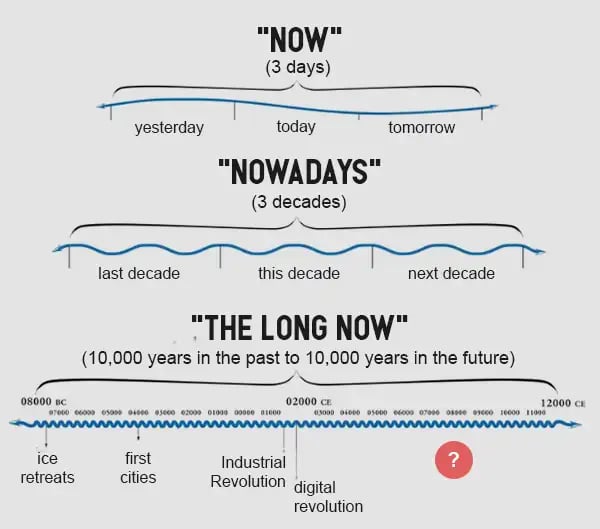
Why do you think people have trouble thinking long-term?
Well, the idea of long-term thinking is very much a luxury. If you’re worried about your next meal, or putting a roof over your head, it’s difficult to think 10,000 years out. You have to be in a position where a lot of other things are taken care of.
Can you give me an example of an institution that is thinking in the long-term?
The Svalbard Global Seed Vault [a long-term facility that houses the world’s largest collection of crops in case of disaster] is an interesting case, as are certain nuclear waste facilities (both in the US and Europe) designed to last 10k, or even 100k, years.
There’s also the story of New College, at Oxford. In the 1800s, they noticed the old oak beams in the ceiling of their dining hall were rotting — and they couldn’t buy new ones, since oak had been over-harvested.
But it turned out that the people who’d built the school 500 years earlier had planted a grove of oak trees for this very reason: They knew the beams would eventually rot, and they planned far ahead for it.
Is there a particularly urgent area we’re failing to apply this thinking to?
An asteroid impact has 100% happened, and will happen again. It could be next month, or in 10,000 years — and that could be it for us. For the first time in history, we have the potential to detect and deter asteroids, but we basically have zero programs to do that.
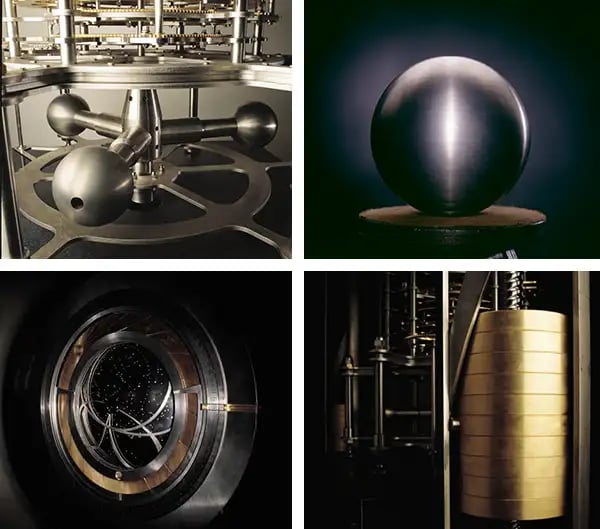
On that pleasant note, let’s turn to the clock! What’s the story behind this thing?
Back in the ‘80s, Danny Hillis [founder of Thinking Machines] was building the fastest supercomputers in the world. People kept asking him to build things faster and faster, and he became disillusioned. So, he started thinking about building the world’s slowest computer — a machine that would counter the “faster/cheaper” mindset.
He wanted to build something monumental and mythic that served as an icon of long-term thinking. The result was the idea of the millenium clock.
And… what is it?
Basically, it’s a giant clock that will keep time for 10k years.
It will tick once per year (instead of once per second), and bong once per century (instead of once per hour). The cuckoo will come out once every millennium.
We built two smaller prototypes over the years, then began construction of the actual clock in a mountain in West Texas. [Note: The project has been funded, in part, with large donations from Jeff Bezos, and is being built on land that he owns.]
We’ve had as many as 40 people on site. The ‘clock team’ has around 10 engineers and 10 fabricators.
Why 10,000 years?
It’s when the last ice age retreated, and it was the origin of cities and agricultures. It’s our modern human technological moment in civilization.
We decided that doing things for an eternity was too dwarfing.
How big is it?
The space we have created inside the mountain for the clock is 500 vertical feet.
The largest component is the chime generator that rings a series of 10 notes in a different sequence each day for 10k years. It’s 60,000 pounds and 80 feet tall. The pendulum, by contrast, is only 7 feet tall.
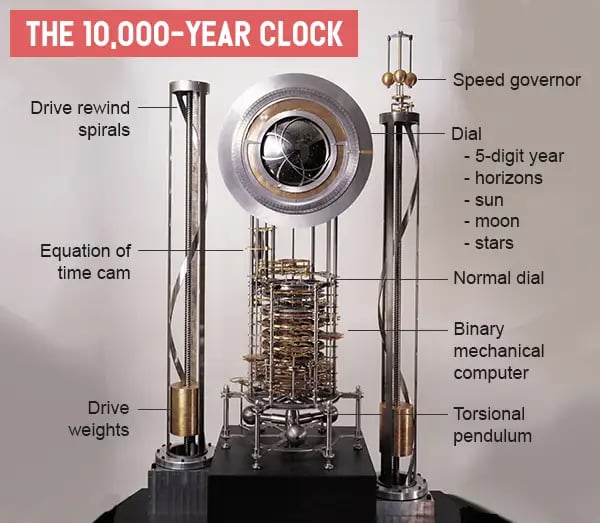
How does it display the time and date?
All the clock dials are astronomic. They show you the current night sky, the moon position and phase, the sun position, and horizons. There is also an area that shows you the Gregorian date. We want to make it easy for the future to reverse engineer it.
The clock always knows what time it is. But all the things that show the time in the clock require people to run it, and update it, and put energy into it.
What have been the biggest challenges with building it?
For one, the natural aspects — everything from mountain lions to bristlecone pine trees, to the heat and cold.
One of the more interesting challenges has been to to design something that is relevant 10k years from now. Clock parts obviously have to work, but they have to look the part as well. Sometimes we’ll come up with a part that is engineered flawlessly, but we’ll look at it and say, ‘Nope, just doesn’t feel right’ — and we’ll start it over.
The basic design principle we’re after starts with a question: If we had burrowed into this mountain and found the clock already there, what do we wish we had found? We settled on this neo-Victorian, mechanical punk vibe. [Detailed schematics here.]
Everything has had to be custom-made, with the exception of some of the screws.
What’s the latest on your progress?
We’re in the middle of installing the clock underground. All the underground work is basically done. Every few months, we’re bringing the next module of the clock into the mountain and integrating it. [A video of recent progress can be found here.]
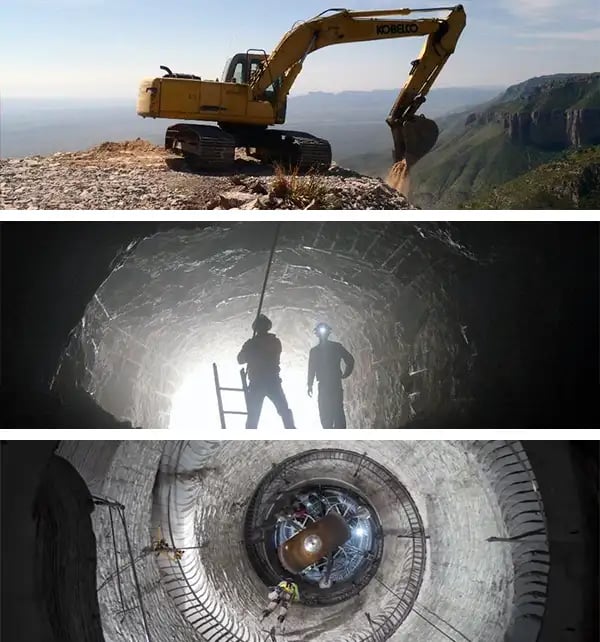
And when will it be open to the public?
We have a year or so more of installation work, and a year of commissioning. Then, we’ll start to have people up to the clock. [NOTE: Mr. Rose reached out to clarify that this doesn’t mean the clock will be open to the public in 2 years. Long Now does not plan to release an estimated completion date.]
The area is very remote high desert — one of the smallest per-capita areas in the lower 48 states. People will have to hike up 2k feet to see it. Hopefully, it’ll be an experience that gives them some time to think about it all.
I can’t help but ask: What exactly is a [multi-million dollar] clock going to do for the world? Why shouldn’t we use that money to tackle problems that exist right now?
The clock is as much about the present as it is about the people of the future.
There are certainly a lot of hungry mouths that could be fed with the amount of money we’re putting into this project. But if all we do is feed the hungry mouths, there will always be hungry mouths. We want to put a dent in the root cause by changing the way people think.
Also, it is a lot of money, but it’s not more than last summer’s blockbuster rom-com. Hollywood movies come and go; I hope our clock will last much longer, and help the world a little bit more, than a rom-com.
What is the bigger legacy you want to impart with this clock?
I hope someone who stumbles across the clock in the future realizes we built it because we cared about them. And maybe it will inspire other people to build things that last, or to work on more ambitious problems with longer timeframes.
If the decisions you make broaden decision making power for the future, they are probably good. The future will always know more than we know. They’ll always have more than we have. Giving them the opportunity to make more decisions is good.
New year, new hustle
No, no, we’re not talking about us. We’re talking about you.
2019 is right around the corner, and that means it’s time to get the jump on some resolutions that’ll actually benefit you.
Forget getting 15 hours of sleep every night. Who are you, Rip Van Winkle? No, it’s the year to do something with real-world returns.
Like finally learning how to take top-notch photos that can make you enough money to pay off that new DSLR you bought. Sure sounds a hell of a lot better to us.
Take your career, passion, or hobby to the next level.
With 7m members and over 25,000 classes, Skillshare is the ultimate resource to help you lock down a new skill in 2019.
Whether you want design chops that supplement your creativity, coding to bring your digital genius to life, or even new marketing strategies to make sure you’re hittin’ that CPA sweet spot, Skillshare is where it all starts.
And because they believe that good things come to those who don’t wait, the first 500 people to use the promo link below will get their first 2 months for free.
(Hint: This is where you stop reading and start clicking.)

